Reporter's notebook
Crossing the High Sierra
Every year, Mary Breckenridge crosses the High Sierra with only her horse and two mules for company. Now, at 64, she’s not sure she can do it alone. Bucko Davis swore he was done with packing, but a long time ago he said he would never tell Breckenridge “no.” He agrees to go.
Times reporter Diana Marcum and photographer Katie Falkenberg accompanied Breckenridge on the trek. Below are dispatches from Marcum’s reporter’s notebook.
Read the story: A High Sierra state of mind
Sept. 2, 2012
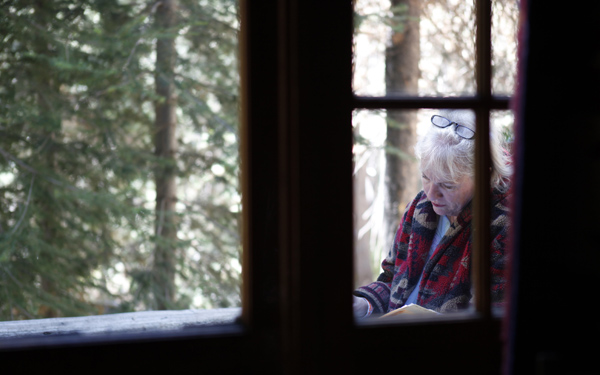
It’s night. Mary Breckenridge is zooming her truck along the narrow, twisting road to Edison Lake.
“You ever get nervous driving in the mountains?” I ask, trying to sound merely curious.
“Never!” she says, accelerating.
Once in the sagging white tent at the “resort,” Mary takes out her bear earrings and her hearing aid, lays down in her sleeping bag on one of the four cots and that’s it, she’s asleep. Her strong, steady snore begins as her head sinks into the pillow. No time wasted on wandering thoughts.
Sept. 3, 2012
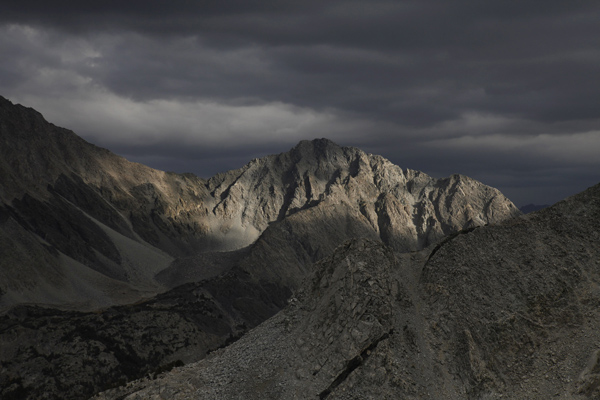
Granite can look ordinary at first.
Take this boulder I’m resting on. It’s rough and speckled with black and white, like its been doused with seasonings. But turn my head just a little this way or that, and sunlight glints off its crystals of quartz and mica.
The Sierra Nevada is largely exposed granite. The Range of Light — as John Muir dubbed it — sparkles.
Mary and Bucko are sitting shoulder-to-shoulder on a boulder, their heads hunched over his beaded medicine bag.
She asks what he puts in it. He says it can be anything that has meaning to him: a pebble, a twig, something from someone he loves. Once it’s in the bag, it never leaves. It becomes one of the pieces that keep him whole. She wonders aloud what she would put in her medicine bag if she had one.
Mary says her solo trips are mostly moving meditations. But she also usually picks a poem to memorize along the way.
I followed suit and brought a work by Phillip Levine, who just finished up a stint as the nation’s poet laureate. He lives in the Central Valley, and his words about our mountains (“If you live here you begin to believe they know everything”) keep playing in my head:
Our ValleyWe don’t see the ocean, not ever, but in July and August
when the worst heat seems to rise from the hard clay
of this valley, you could be walking through a fig orchard
when suddenly the wind cools and for a moment
you get a whiff of salt, and in that moment you can almost
believe something is waiting beyond the Pacheco Pass,
something massive, irrational, and so powerful even
the mountains that rise east of here have no word for it.You probably think I’m nuts saying the mountains
have no word for ocean, but if you live here
you begin to believe they know everything.
They maintain that huge silence we think of as divine,
a silence that grows in autumn when snow falls
slowly between the pines and the wind dies
to less than a whisper and you can barely catch
your breath because you’re thrilled and terrified.You have to remember this isn’t your land.
It belongs to no one, like the sea you once lived beside
and thought was yours. Remember the small boats
that bobbed out as the waves rode in, and the men
who carved a living from it only to find themselves
carved down to nothing. Now you say this is home,
so go ahead, worship the mountains as they dissolve in dust,
wait on the wind, catch a scent of salt, call it our life.
Sept. 3, 2012
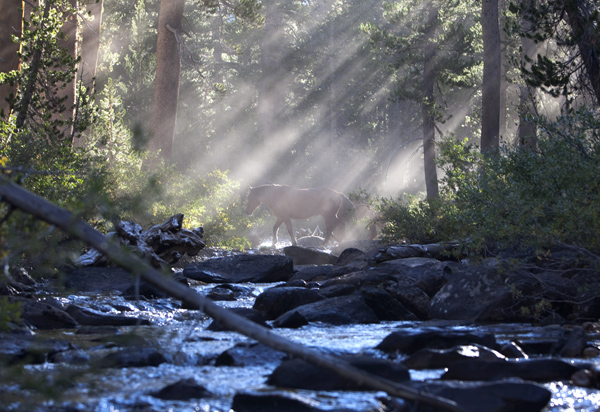
Here’s the thing. There really is nothing to experiencing wilderness, or to riding a horse — until suddenly there is.
My horse, Bishop, is trained to just walk along, following the trail horse in front of him. Anyone who can sit upright can manage to handle that, right?
So not 10 minutes into our first day on the trail, as we’re moseying through pine trees and swarms of butterflies, Bishop starts bucking.
“Bucko! Help!” I shout to the front of the pack line.
“Pull up his head,” Bucko Davis yells.
I’m trying to pull the reins up when Bucko yells at me to give Bishop his head and kick his sides
Give a bucking horse his head? But I trust Bucko. I give Bishop all the reins, and he surges forward.
Then I can Mary shouting: “Bees!”
Sept. 4, 2012
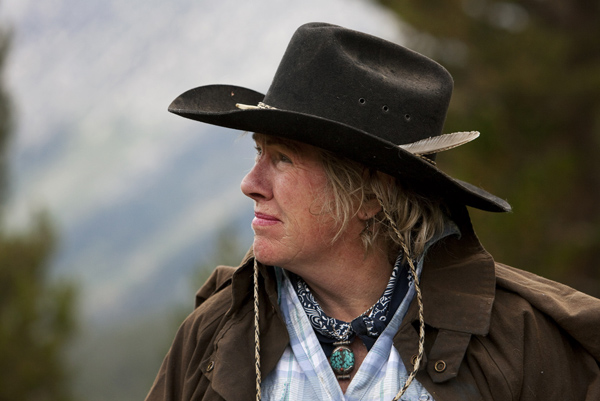
The images keep changing, one luminous picture laid atop another, until I lose track of the individual snapshots.
The ground is covered with Mary’s favorite flower, shooting stars. They’re past bloom, but still add a feathery touch to a dense carpet of leaves.
Fluttering leaves on the aspen flash sunlight around like a disco ball. Their white trunks are dotted with shadows, circular designs that make it appears as though they’ve been collecting passport stamps.
We pass two backpackers. Mary gives them a hearty hello, asks where they’re going, where they’ve been. She has stopped to talk to everyone we’ve crossed paths, trying to inject friendliness into a thorny debate about land use.
Some backpackers think horses and mules don’t belong in wilderness areas. Some horse people disagree — they were in these mountains a long time before anyone ever bought an ultralight backpack at REI. Last spring, all horse packing trips were suspended for a while in Sequoia Kings Canyon National Park because the government feared an environmental lawsuit over the park not properly managing packing stations.
Unprompted, one of the backpackers, a woman from the Valley, exclaims: “Oh, I love seeing horses in the Sierra!”
“Really?” asks Mary.
“Oh, yes,” says the backpacker. “I want there to be a way for me to be out here when I’m too old for hiking.”
Sept. 4, 2012
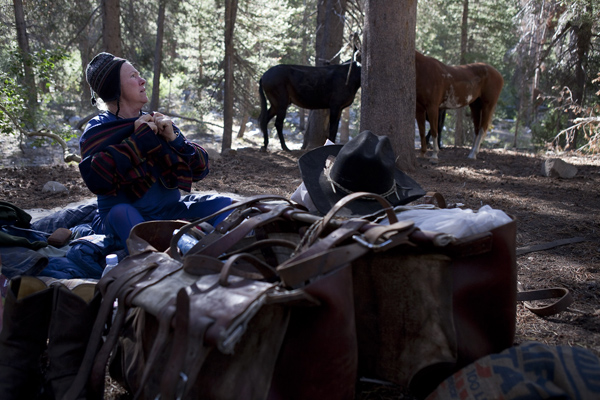
I can’t put my finger on what exactly is wrong. It’s not a headache, but my head feels almost like it’s floating away from my body.
I find a flat rock and do a few yoga stretches to see if that helps. Wilderness survival tip here: If you should ever find yourself at high elevations and feeling very strange, Downward Dog is not the answer.
I try to set up my tent. It usually takes less than two minutes. But this time it’s beyond me how to push the little rods together. Then I can’t remember why I’m trying to push the little rods together. Then I think — and this is an odd thought — that I can’t think.
I see Bucko at the campfire and walk, zombie-like, over to him.
“Are you OK?”
I shake my head no.
“What’s wrong? “
I can’t form words. I’m utterly terrified.
He says he feels really weird too. It’s just that we’re flatlanders, he says, and we haven’t had a chance to acclimate to the elevation.
Sometime in the night I wake up and it’s as if someone has put an oxygen mask on my face. All of the sudden I can breathe down to the bottom of my lungs.
Sept. 5, 2012
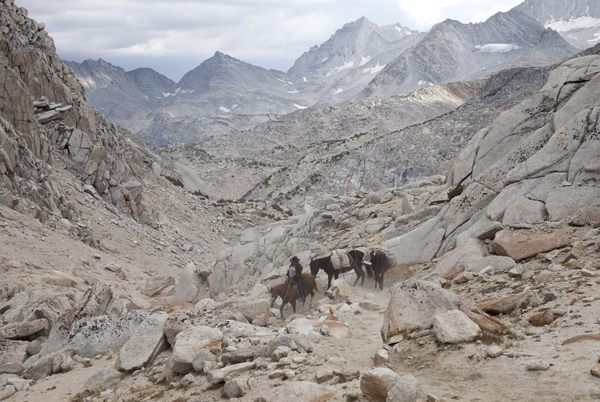
A mountain peak and a mountain pass are very different things.
On the peak, you look upon a world lavishly spread out for your viewing. A pass is restricted, tunneling you between otherwise impassable mountains.
Granite towers lean in over us from both sides as we ride. The horses have to stop every few minutes to catch their breath. Bishop is sweating a little and he’s jumpy. I don’t blame him.
There’s a lake, it’s mottled slate surface reflecting the bleached rocks and darkening skies. We trudge down there so the animals can drink. I’m having fanciful notions of it opening up or turning into a monster the moment it’s touched. The horses seem to feel the same way. They stand there a long time before lowering their heads.
Sept. 5, 2012
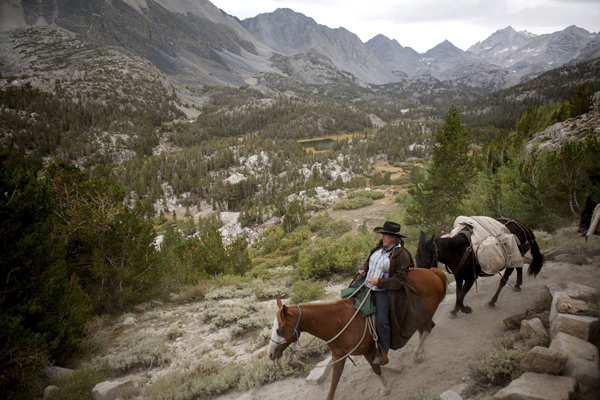
We emerge from the stark pass onto the Eastern Sierra.
The switchback trail guiding us toward the brilliant turquoise lakes below is the steepest of our trip — and there is loose rock.
Every time Bishop stumbles, my heart jumps into my throat. Each time, he quickly recovers his footing and I pat him with deep gratitude.
We’re all riding with our stirrups pushed forward, bracing back with our legs as the horses go down this natural staircase. Everyone is quiet, except for Mary.
“Do you see why I don’t go to church? This is my church!” she shouts.
| Advertisement |
|
|
This page was created by the Data Desk, a team of reporters and Web developers in downtown L.A.
- Track our latest projects »
- Fork our open-source code on Github »
- Send us e-mail at datadesk@latimes.com »
